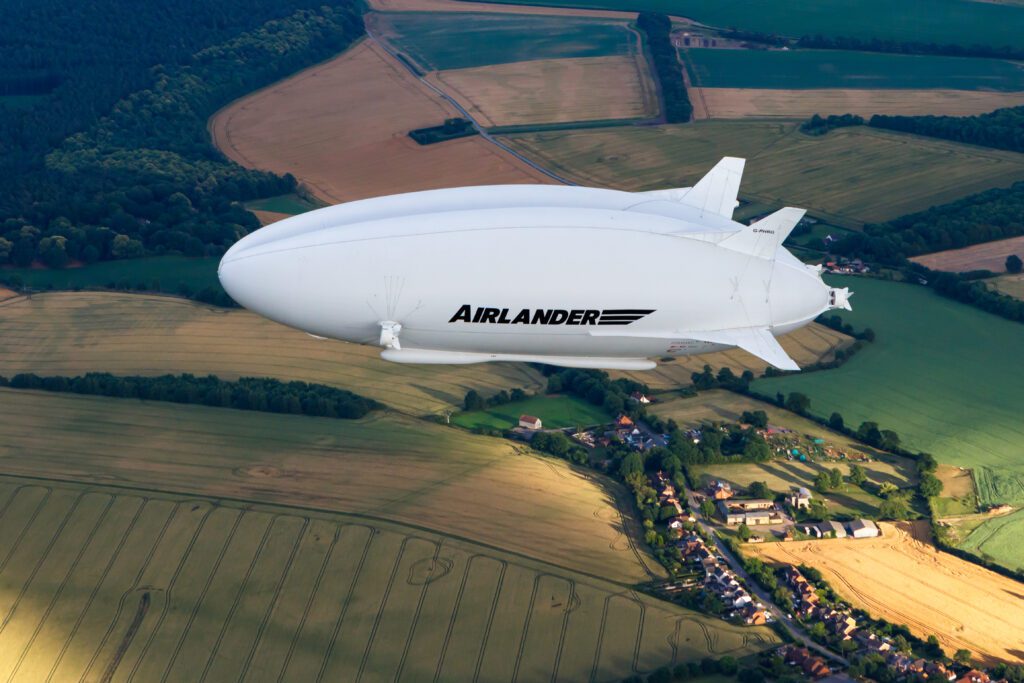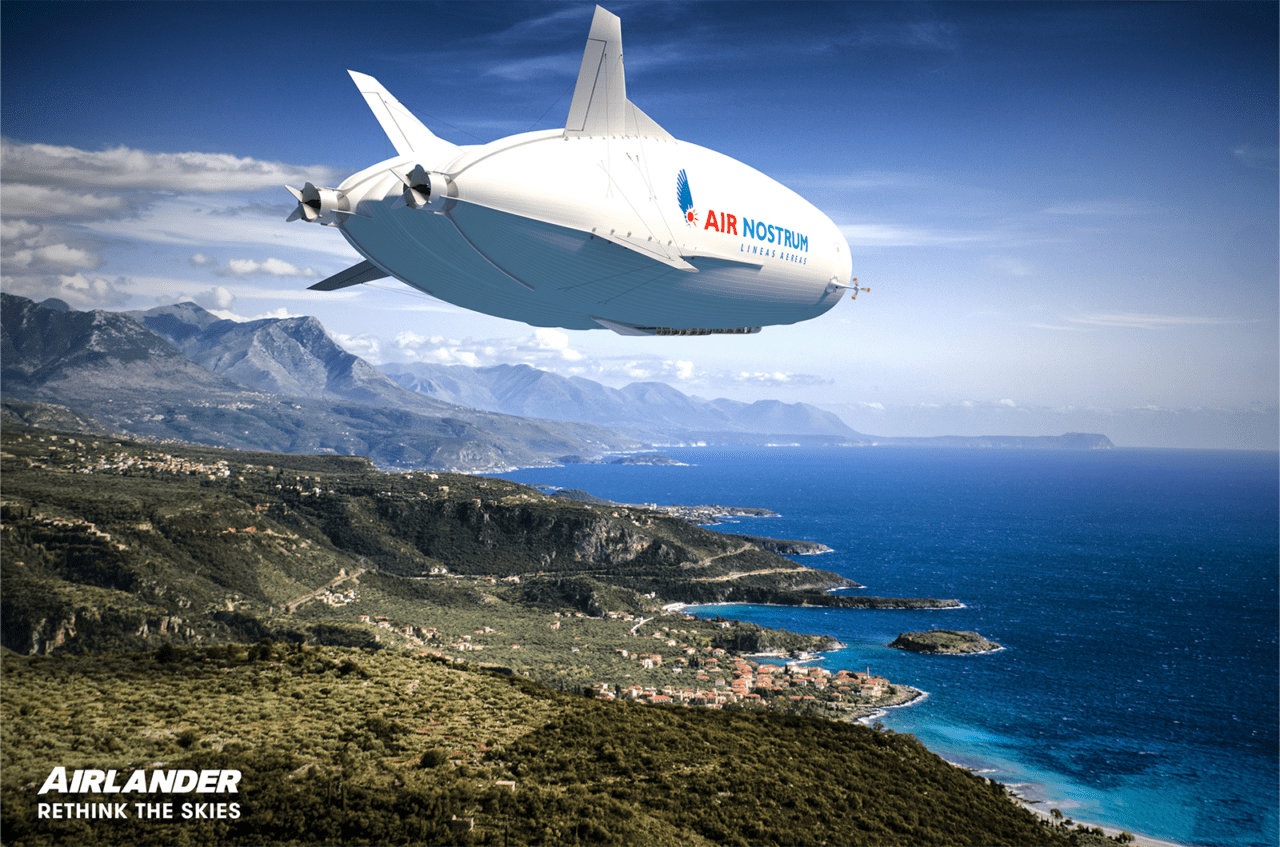Hybrid Air Vehicles, the company that designs the Airlander 10 hybrid-electric aircraft, has reached an agreement with Air Nostrum. As part of the deal, Air Nostrum has reserved 10 aircraft from HAV for its fleet, with operations expected to begin in 2026. (Photo courtesy of Hybrid Air Vehicles)
Air Nostrum Group, one of Europe’s largest regional airlines, has booked 10 hybrid-electric aircraft from UK-based Hybrid Air Vehicles (HAV). HAV’s aircraft design, the Airlander 10, is expected to launch in 2026, when Air Nostrum plans to begin operating the 10-plane fleet in Spain.
“We’ve spent the last few years developing and testing a production design that will work for many different customers,” HAV COO Nick Allman shared in an interview with International Avionics. The aircraft was originally designed with the military surveillance market in mind, but HAV has more recently shifted to focus on a much wider market.
The Airlander 10 will have a top speed of 80 miles per hour and the maximum range is 4,000 nautical miles. The aircraft’s maximum payload is also expected to be around 22,000 pounds. The aircraft design features a helium-filled hull to reduce the fuel needed to keep the vehicle airborne. The HAV team intends to develop a version of the Airlander 10 that will be fully electric and ready to enter the market by 2030.
Interest in HAV’s fuel-efficient aircraft for short-haul mobility has grown over the past two years, particularly due to the growing focus on sustainability in air travel. The Airlander 10 is designed to produce approximately 10% of the emissions of a conventional aircraft. To meet the needs of the short-haul mobility market, Allman explained, they added a larger cabin to the plane with a capacity of 100 passengers.
In addition to relatively short flights, HAV is also considering applications in the tourism market for its aircraft. This market “is more like a cruise liner in the sky,” he said, “for a two- to three-day flight at a relatively low altitude to go somewhere that is otherwise very difficult to see.” . The company continues to explore surveillance applications consistent with the original aircraft design. The vehicle surveillance model would have a battery life of more than 5 days and could serve both military and civilian communication applications.
“We’ve made changes to some of the basic aerodynamic characteristics of the aircraft” over the past two years, Allman said. The changes were mainly aimed at efficiency and ease of use. The Hybrid Air Vehicles team uses a flight simulator, which has been calibrated against flight test data from their prototype, to explore possible design modifications and alternative methods of operation.

“We’ve spent the past few years developing and testing a production design that will work for many different customers,” said Nick Allman, chief operating officer at HAV. (Photo courtesy of Hybrid Air Vehicles)
There were many hurdles in the development of the Airlander 10. However, Allman said, they gained tremendous experience as they progressed through the design. And this experience allowed them to take an important step: “We are the only campaign to have flown a full-scale hybrid aircraft,” he noted.
The UK jobs market is currently very strong, he said, which benefits HAV’s long-term growth strategy. The company currently has around 60 employees, but plans to grow to nearly 2,000 in the next few years.
The team is working with regulators in the US and Europe in addition to those in the UK to ensure the Airlander 10 can operate safely once it enters the market in 2026. Production of the aircraft is due to start later in 2022, in South Yorkshire, UK HAV is working closely with local and central government as well as other partners to establish its facility there.
The European Union Aviation Safety Agency (EASA) awarded HAV a Design Organization Approval (DOA) in 2018. That same year, the company also received a Production Organization Approval (POA). ) by the UK Civil Aviation Authority.
Hybrid Air Vehicles expects the Airlander 10 to be subject to the same essential regulations as any large aircraft. “While some of the smaller eVTOL-like products require quite a significant regulatory change depending on their level of technology,” Allman explained, “we don’t need a regulatory change at any of those points in the chain to be able to successfully operate the aircraft.” An example of a difference in HAV aircraft is the lack of metal landing gear, an aspect of standard aircraft that is heavily regulated.
Allman shared that he doesn’t foresee any problems in the production phase and that their team is already working on the operational side of things, even though it’s four years away. “We are absolutely convinced that [regulations for the aircraft] will not be an obstacle for us. We try to stick as closely as possible to the way aircraft are currently regulated,” he added.
Carlos Bertomeu, president of Air Nostrum, pointed out in the HAV announcement that they entered into this agreement because of the dramatic reduction in emissions offered by the Airlander 10 aircraft. “Sustainability is already a non-negotiable fact in day-to-day commercial aviation operations,” Bertomeu said. “Agreements like these are a very effective way to achieve the decarbonization goals envisioned in the Fit for 55 legislative initiative.”
In addition to the Airlander 10, Hybrid Air Vehicles has conceptualized a larger model called Airlander 50 for the transport of heavy goods. The design of this vehicle includes a payload of approximately 110,000 pounds or 55 tons and a capacity of 200 passengers. According to HAV, the all-electric version of the Airlander 50 could be available to customers by 2033.

